Inside the Chimneys at St Adolphe, Assiniboine Park Zoo and Selkirk

In last week’s blog (“That’s a wrap, Folks”) Amanda shared the news that “our last known Chimney Swifts have departed for the season!”. While that signals the end of Chimney Swift monitoring for the year, it also signals the start of another phase of work for us at MCSI – it’s chimney cleanout time. Glorious work it is!
At nest sites, the physical evidence observed at the bottom of the chimney reveals the story which unfolded in secrecy…all those entries and exits observed by our dedicated monitors, translated into breeding swifts moving through the various stages of nesting. By looking at the cleanout, we see tangible evidence of breeding attempts: twigs or nests; eggshells (whole or halves); sadly, some carcasses of the unfortunate young who didn’t make the journey up and out of the chimney; feathers shed by the swifts; and poop – the more swifts at a site, the more the poop piles up.
In St. Adolphe, two of the five nest site chimneys have cleanout traps. The Brodeur Bros/Daycare cleanout material indicated that 8 eggs were laid. One egg was intact which means no hatching took place. One egg held the remains of a chick which didn’t complete its hatch; the egg was totally pipped but the bottom half of the egg was still stuck to the wee chick. The six remaining eggs hatched successfully in early July when we were under the serious heat dome weather warning. Behaviour observations indicated that the adults quickly ran into trouble and all daytime activity at the site was done three days post-hatch. It is likely that there wasn’t enough food to feed the chicks and/or some temperature stress took place. No matter the outcome of the breeding attempt, the staff, families, and children of the daycare continue to be Chimney Swift fans. This new daycare features a “Chimney Swift hub” meeting place near the chimney side, so a new generation of environmentally conscious kids is being nurtured.
At the Main St site in St Adolphe last year, a breeding pair couldn’t get traction on a breeding attempt. They were likely first-time parents. But what a difference a year makes. The breeding pair returned this spring (the Kyles in Texas report that tagged adults do return to the same nest sites) and got down to nest building on June 3. Five eggs were then laid. All the eggs hatched and all the juveniles fledged successfully! On fledging day, I saw a follow-the-leader event where an adult made a slow, cautious drop entry into the chimney after leading the newly airborne youngster along the approach path. But the fledgling didn’t make a good entry – it missed the open chimney and tumbled down the east face of the chimney, disappearing briefly behind the roof. The fledgling recovered altitude and flew off for a try another time. It was likely heart stopping action for the fledgling. I know it was for me! Now the daytime behaviour observations I made picked up only one fledgling but the physical evidence revealed five fledglings were airborne. Behaviour observations may underestimate fledging success. Remember this when Amanda updates us with Tim’s big news on the Selkirk Mental Health Centre large stack replacement tower (Tower 4)!
Both the St Adolphe cleanouts had twigs and dropped nests (this is normal but we want the nests to fall after juveniles successfully transfer from the bowl of the nest to the chimney wall at 20-21 days of age). Feathers and guano (that glorious poop) were found in both cleanouts also. I’ll sign off and hand the blog update back to Amanda
– Barb Stewart
And now it is my turn for next updates! As Barb mentioned, ‘tis the time of year we can open up the chimneys to see if we can confirm the nesting events that we observed through the birds’ behavior earlier in the season. Or in some cases get an idea of what happened, when the Chimney Swift behavior went off the rails (I am looking at you Chimney Swifts of tower 4 at the Selkirk Mental Health Centre).
We will start off with our oldest of the Chimney Swift towers that gets used – the Assiniboine Park Zoo tower. Adam Grottoli has been our go-to contact for the Zoo this year and the two of us opened up the Zoo’s Chimney Swift tower on September 21st. The tower bottom looked quite clean when we opened it up. There was a hardened black mass in a corner opposite the nesting wall, likely a combination of decomposing leaf litter and Chimney Swift guano (poop), as well as decomposing leaf litter along the bottom of the tower. The nest was entirely intact, with just a few pieces of twigs separated here and there that seemed like they probably never made it into the nest in the first place.
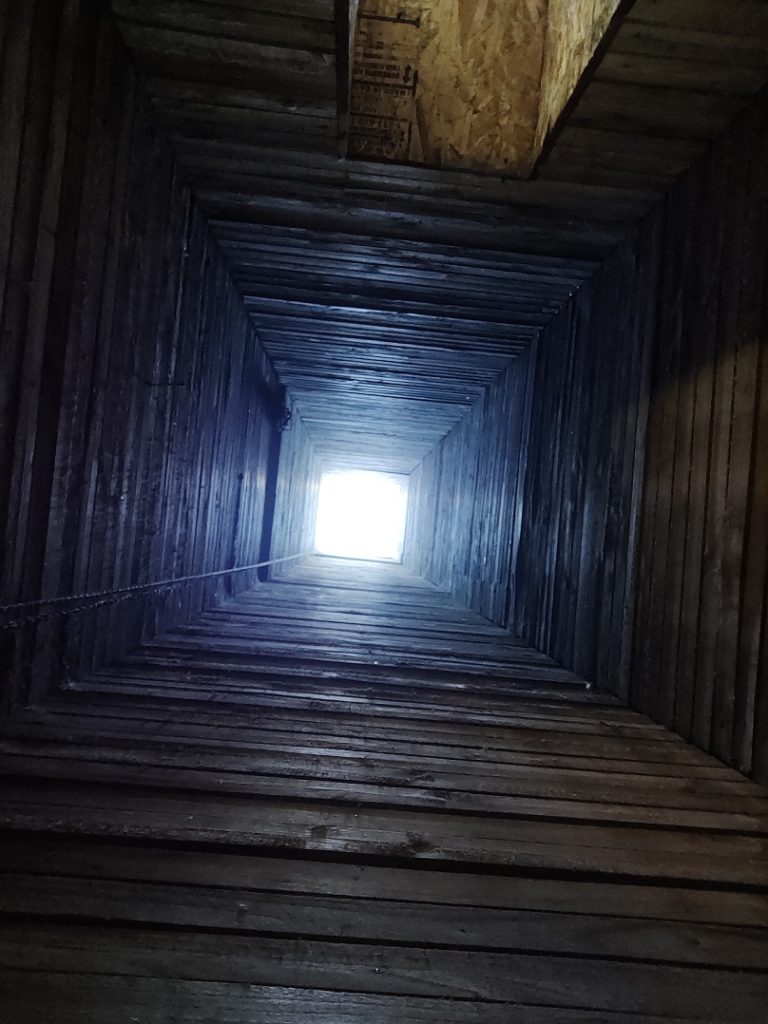
Can you spot the nest on the wall of the Assiniboine Park Zoo tower? Look on the wall with the string running up the side!
We were able to find the eggshells of two hatched young. There were no intact eggs (so all the young hatched) and both hatched young made it to fledging, which matched MCSI’s and the zoo’s monitoring records! While Adam and I were talking to a passerby through the zoo fence about a drumming noise coming from the chimney, the noise suddenly started up! Sure enough, out flew the culprit, a Pileated Woodpecker who has called the chimney home over the summer, and apparently into the fall. The Pileated Woodpecker had no fear, as it moved to the side of the chimney just above our heads and hung out there for a bit before it flew off. The Zoo has patched three previous holes in the chimney, and it looks like there is a fourth hole to be patched now. The outside of the chimney is treated wood to make it withstand the elements, but it was not designed to have the inside exposed to the elements, nor to be a safe roosting site for woodpeckers! We will be working on how to remedy this situation going into the future. Until then, if you want a good look at a Pileated Woodpecker, go hang out by the Assiniboine Park Zoo Chimney Swift tower!
On September 23rd, Tim Poole, Rob and Barb Stewart, Joanne Tuckwell and myself went to check out the Chimney Swift Towers at the Selkirk Mental Health Centre. Tim and Gerald Machnee had opened up three of the four towers and the infirmary building chimney a week prior, but due to birds still using T4 that tower was left closed at the time. So we checked out T4 as well as a few of the other towers.
Our first stop is Tower 1 (tall tower at west end of site). The tower was occupied by a pair of Chimney Swifts in June however, they did not breed inside the tower. A single swift was seen using the tower in July.
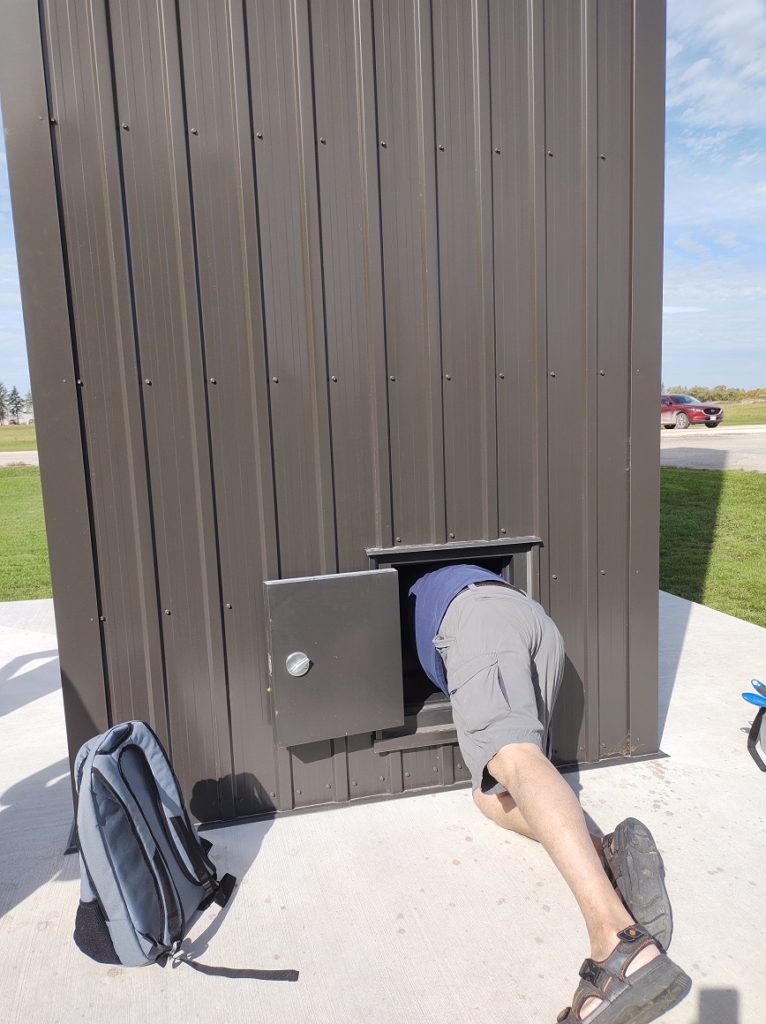
Next, we have tower 2 (eastern tower in the trees). This tower was the first to be used by swifts. A pair did use the tower in May and June. Photos taken by a camera trap that Tim Poole with province had set up inside the tower indicated that they mated. There was however, no material associated with breeding when Tim and Gerald opened it up. So, for some reason the birds did not stick with this tower
Tower 3 (tower attached to the old infirmary building) was rarely used early in the spring. However, a single bird was seen roosting in T3 in July. We believe this might have been what is known as a helper, a non-breeding adult assisting the successful breeding attempt in the chimney on the same building. The bird partially moulted inside and feathers were seen.
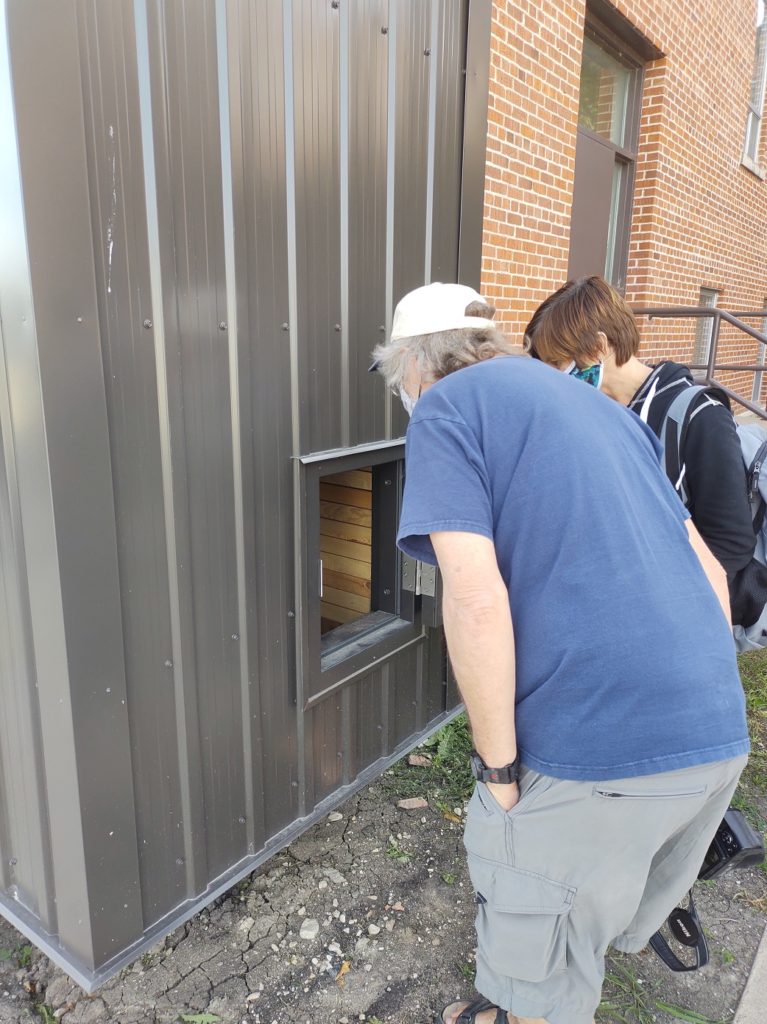
Tower 4 was the exciting one that we got to look inside for the first time on September 23rd! Tim’s summary and results are as follows,
“Tower 4 (tower on site of old powerhouse building chimney) – The tower was completed around June 18th, 2021. Even before it was completed, I noted that swifts were already flying over top of the entrance. Swifts were roosting inside during the first roost monitoring session post-tower completion which was somewhat surprising. We wondered if they might be the birds photographed in tower 2. There was some use in July but activity picked up in August. There was some confusion at this point as the tower was completed too late for breeding swifts. The theory was that fledged birds from another chimney had moved into the tower. The pattern of behaviour which continued to be observed in August and early September increasingly resembled feeding of chicks and I noted behaviour consistent with fledged birds on September 9th. Today we opened it up and pulled out the fragments of 3-4 eggs. There were no chick carcasses, although the nest was still on the wall. This is by some way the latest ever recorded successful Chimney Swift nest in Manitoba. The nest was on the south wall about halfway up the tower and is already falling apart. Interestingly, many nests come down intact, so my guess is that we had inexperienced parents (this would also explain the late nesting attempt). The final score in the tower won’t be revealed until the nest falls, but our observations suggested a minimum of two fledged birds.”
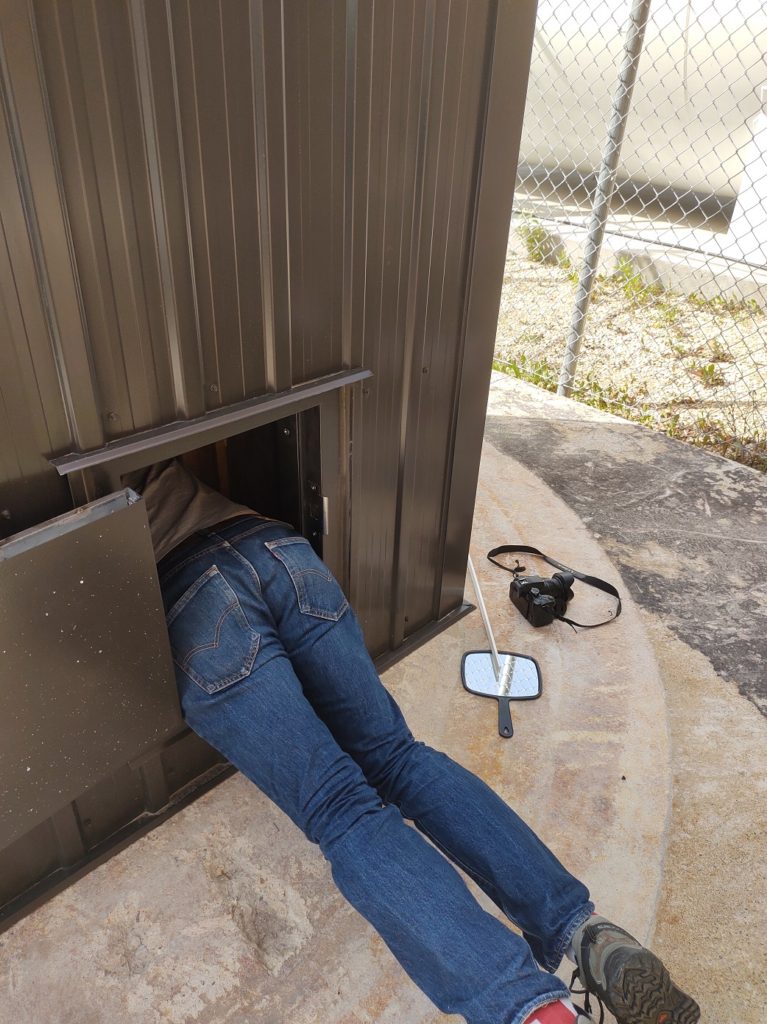
Tim entering into T4. He managed to get back out – minus a hat that was retrieved afterwards! This tower was built on the cement pad of the old big stack, you can see the outline of the old stack on the cement under Tim’s legs.
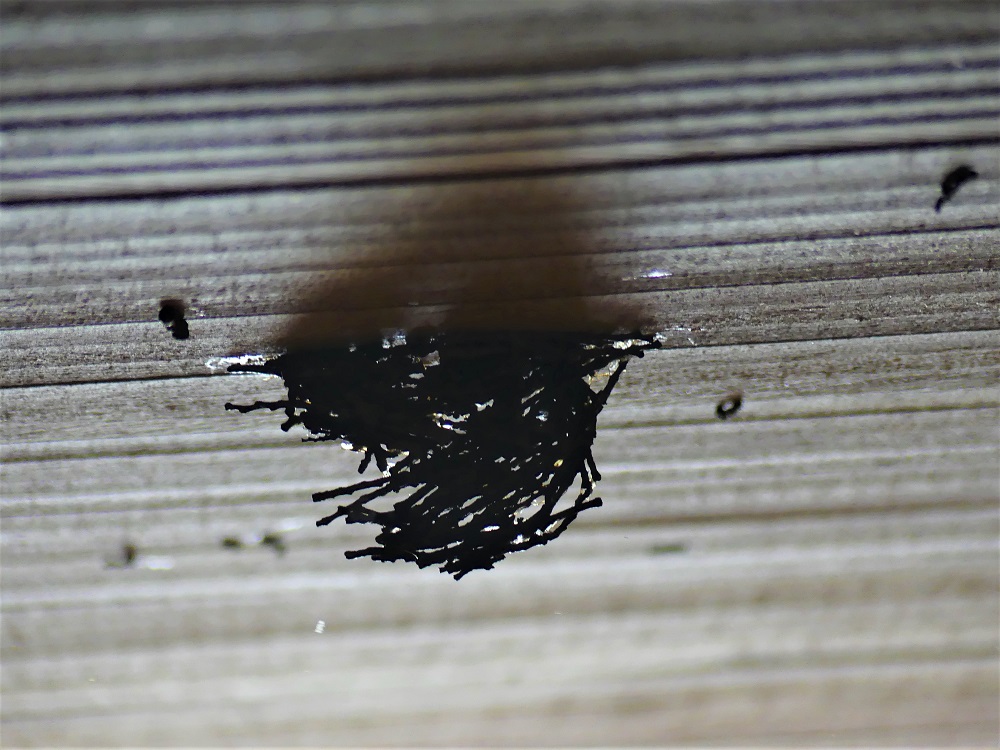
The nest still up on the wall of T4. You can see that it is slowly coming apart. You can also see the light reflecting off the glue-like spit that the swifts use to hold their nests together, and hold the nest to the wall (in the right and left corners of the nest). Photo by T. Poole.
Tim sums this all up with “I would say that use of all towers and successful nesting is actually a big success for this year. The data suggests the birds found the towers and like what they found”. Of the non-tower sites at the Selkirk Mental Health Centre, both the infirmary building chimney and the yellow brick chimney also both hosted successful nests.
And that about sums up our Chimney Swift monitoring for this year! You will still be hearing from us about Chimney Swifts periodically through the winter and fall. Now that we have all of our results, Barb and I will work on tallying and summarizing our monitoring results St Adolphe and the rest of the province for everyone to take a look at.
- Amanda and Barb
P.S. Need a bigger Chimney Swift fix? We have come across several videos and resources that might interest you!
The differences between Swallows and Swifts by the National Audubon Society: https://www.audubon.org/news/is-swallow-or-swift
Georgean and Paul Kyle (of Chaetura Canyon Nature Centre) have been periodically livestreaming swifts entering chimneys in Texas. The livestreams don’t happen every night but the recordings are still available to view on Facebook afterwards! https://www.facebook.com/paul.kyle.16100
Want to see a roof-eye view of swifts entering a chimney? Thanks to Nature London you can see what this looks like first hand! https://www.youtube.com/watch?v=zM-mvmER4zM
You can also take a look at what Chimney Swift rehabilitation can look like! https://www.facebook.com/watch/?v=196653735894782
